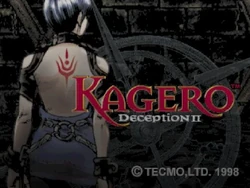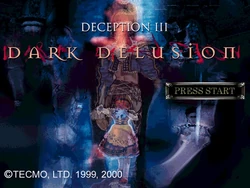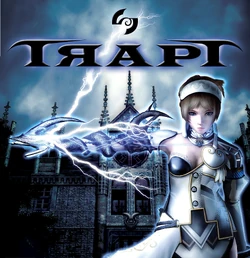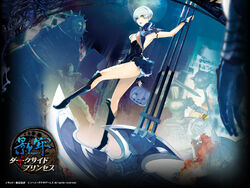The Deception games are a series of console Action-Style strategy-RPGs created and published by Tecmo for Sony's line of PlayStation consoles. They have an emphasis on passive combat via the use of traps. There are currently five games, and an expansion, in the franchise.
Games[]
Tecmo's Deception[]
- Main article: Tecmo's Deception: Invitation to Darkness
The first game in the series,

released in 1996 for the PlayStation, Tecmo's Deception plays unlike its successors in almost every capacity. It uses a first-person perspective similar to the then-popular King's Field series. At the time, Tecmo's Deception was also rather controversial with its storyline about a murdered, nameless prince who makes a pact with the Devil to become the master of what's known as the Castle of the Damned, in order to get revenge on his brother Yurias, who framed him for the murder of their father, the king, in order to usurp the throne and claim the fiancée of the player, Princess Fiana.
In addition to the rating of Teen (for animated violence and blood), the back of the game's jewel case contains an additional disclaimer which reads: "WARNING: This game contains satanic references and may be inappropriate for some individuals." All later Deception titles, although no longer about service in Satan's name, received ratings of Mature.
The first Deception is home to a number of features that would never be seen again throughout the series' run. First, it is played from a first-person viewpoint, lending the game a different playstyle from its successors. Secondly, instead of being limited to position one wall-, ceiling- and floor-based trap in each castle room, the player can place as many traps as room space and Magic Points allow, although all traps vanish after striking an invader once, and so must be reconstructed if invaders dodge or survive them all. Third, monsters can be constructed from captured invaders' body parts and summoned using "Block Orbs" to fight for the player. Fourth, the Castle of the Damned can be built onto and expanded with more rooms. Finally, each "family" of traps has only two upgrades, and are merely stronger variations of existing traps. This game is also the most RPG-like of the series, with an emphasis on carrying and using items, increasing stats with item upgrades, and gaining character levels by killing or capturing invaders. Tecmo's Deception contains six different endings which can be attained by making different choices at key storyline junctions, and saving requires nine blocks—over half of a memory card.
This game was released as Devil's Deception in Europe.
Kagero: Deception II[]
- Main article: Kagero: Deception II
Shifting the viewpoint

to third-person and the emphasis to trap combos, Kagero: Deception II formed the foundation of current Deception titles and would be built upon in future titles, coming out two years after its predecessor. In it, players assume the role of Millennia, a young girl being used as a puppet and guard for a race known as Timenoids (or TMD, as the game abbreviates their race's name), who are like humans except immortal, and whose power is desired by the humans whose lives they govern. Millennia finds herself in the middle of the war between her own race and her captors, with her chosen side dictated by the player. One of the endings to the game heavily implies that Kagero is a prequel to Tecmo's Deception, and that Millennia will grow up to become Astarte from the first game; this interpretation is supported by the fact that naming the main character in Kagero "Astarte" lets you start with a hefty sum of extra Ark (the game's currency). However, Tecmo has not made it clear if that ending is canon.
The change in how traps functioned gave this game a much more strategic edge than the first game, with traps able to interact with one another in long strings that could be likened to Rube Goldberg set-ups, just much more lethal and involving other people. Instead of using items such as medicinal herbs, healing was accomplished via glowing blue crystals called "loons" which could only be touched once before breaking, never to be used again in a given chapter. Trap improvement was conducted by using the points earned after successfully killing each invader, called Ark, and by following a somewhat logical "tree"—improving an Arrow Slit after a Lightning Rod was created could make a Laser Arrow, for instance. Six secret traps (one of which depicted Suezo, a popular monster from Tecmo's own Monster Rancher titles) could be unlocked in future replays by completing the game and achieving all four endings in the game, as well. Traps, when constructed, could be used as often as the player liked, but required a recharge time between uses in any given level. Game saves are one block in size.
Deception III: Dark Delusion[]
- Main article: Deception III: Dark Delusion
Deception III: Dark Delusion

expanded on the gameplay of Kagero by introducing a training mode, a mission mode, and trap enhancement through a series of crests and other artifacts. In the main story mode, players control Reina, a girl who, with her adoptive family, has been kidnapped and brought to the land of Burgenhagen to be sold into slavery. Reina must use the trapping powers she acquired to defeat her kidnappers and solve the mysteries of the pendant she wears, which other people seem to covet for unknown reasons.
The Free Training mode is simply a means of testing all of the available traps in a controlled environment with an immortal invader who can be programmed to adopt behavioral patterns, to learn their effects and uses without any real consequences. The mission mode, known as Expert Mode, assigns the player a given goal to achieve, usually within a time limit, with the traps available being any unlocked up to that point. Typical missions include "Crush the invader with a 4-hit combo" and "Make the killing hit a Pendulum trap." Also included is a Trap License mode which functions as a further tutorial, asking the player to perform various tasks that teach the nuances of the game in the name of learning helpful tips or trap functions. Traps are even more customizable than in previous games through the uses of Base Circles, Orbs, Emblems, and Rings. Base Circles contain the variety of trap involved (Pendulum, Arrow Slit, Bear Claw, etc.); Orbs determine the power level of the trap, ranging from 1 to 4; Emblems give the trap an element or special characteristic (Lightning, Fire, Slave, etc.); and Rings further enhance a trap by increasing their power, shortening their charge time, or a myriad number of other changes. The more modifications a trap employs, the more "Dreak" (the replacement for Kagero's Ark) it takes, but again, traps could be used infinitely upon creation. The loons from Kagero also returned as the sole means of regaining lost hit points. While not having secret traps, special emblems and rings can be acquired by achieving the game's four endings. Game saves are one block in size.
On release, Famitsu magazine scored the game a 31 out of 40.[1]
Trapt[]
- Main article: Trapt
Trapt was marketed

as Kagero II: Dark Illusion in Japan. Players now control Princess Allura, a maiden who runs away from her kingdom after being framed for the murder of her father, and who enters into a similar demonic contract with a being known only as "Fiend" to get revenge on her pursuers.
This game utilizes what are known as "Dark Illusions"—specialty traps which are contained within the room of any given castle, and require a special sequence of triggers in order to be used. Furthermore, at certain points in the storyline, side stories can be explored which present some alternate scenarios from the main plotline, providing more backstory on the game's events. Included in the game's menu is a Survival Mode, which pits Allura against waves of invaders with only nine traps at her disposal—three ceiling, three wall, and three floor. Creating new traps necessitates the spending of "Warl", like Ark and Dreak before it, and is done similarly to Kagero through the use of a logical tree. Secret traps and settings can be purchased with Warl by finishing the game and unlocking the three endings, collecting preset amounts of Ark, or by killing all encountered invaders. Saving the game requires 64K of free space on a PS2 memory card.
Deception IV: Blood Ties[]
- Main article: Deception IV: Blood Ties
Deception IV: Blood Ties is a

game for the PlayStation Vita and PlayStation 3 by Tecmo Koei, and sequel to Deception III: Dark Delusion.[2][3][4] The game is a revisit of Tecmo's 1996 PlayStation game Tecmo's Deception: Invitation to Darkness, and features similar trap-based strategy gameplay. The game was announced at the SCEJ Press Conference in September 2013 prior to the Tokyo Game Show, and it was released on February 27, 2014 in Japan, March 25 in North America and March 28 in Europe.[5]
The Nightmare Princess[]
- Main article: Deception IV: The Nightmare Princess
Deception IV: The Nightmare Princess

is an expansion pack to the game Deception IV: Blood Ties.
Tecmo Koei announced Deception IV: The Nightmare Princess for PlayStation 4, PlayStation 3, and PlayStation Vita in a Famitsu magazine published on the December 12, 2014.
Players are able to take the role of Velguire, a new maiden that has the ability to stomp on her victims for extra damage. Other characters from previous Deception games are met in the newly added Quest Mode where players will have to face off against them. These characters can also be used in-game by the player.
Deception IV: The Nightmare Princess was released on 26 March 2015 in Japan.
References[]
- ↑ プレイステーション - 蒼魔灯. Weekly Famitsu. No.915 Pt.2. Pg.22. 30 June 2006.
- ↑ 2013-09-09, Samurai Warriors 4, Kagero sequel announced for PS Vita, Gematsu
- ↑ 2013-09-09, 【速報】プレイステーション Vitaで『戦国無双4』と『影牢 ダークサイド・プリンセス』が発売決定【SCEJAプレスカンファレンス】, Famitsu
- ↑ 2013-09-19, Deception IV: Blood Ties coming west in early 2014, Gematsu
- ↑ Romano, Sal. "Deception IV: Blood Ties release date announced". Gematsu.
Deception
|
|---|
| Games |
| Tecmo's Deception: Invitation to Darkness Kagero: Deception II Deception III: Dark Delusion Trapt Deception IV: Blood Ties • The Nightmare Princess Kagero ~Trap Girls~ |
| Reoccurring Themes |
| Trap • Class |
